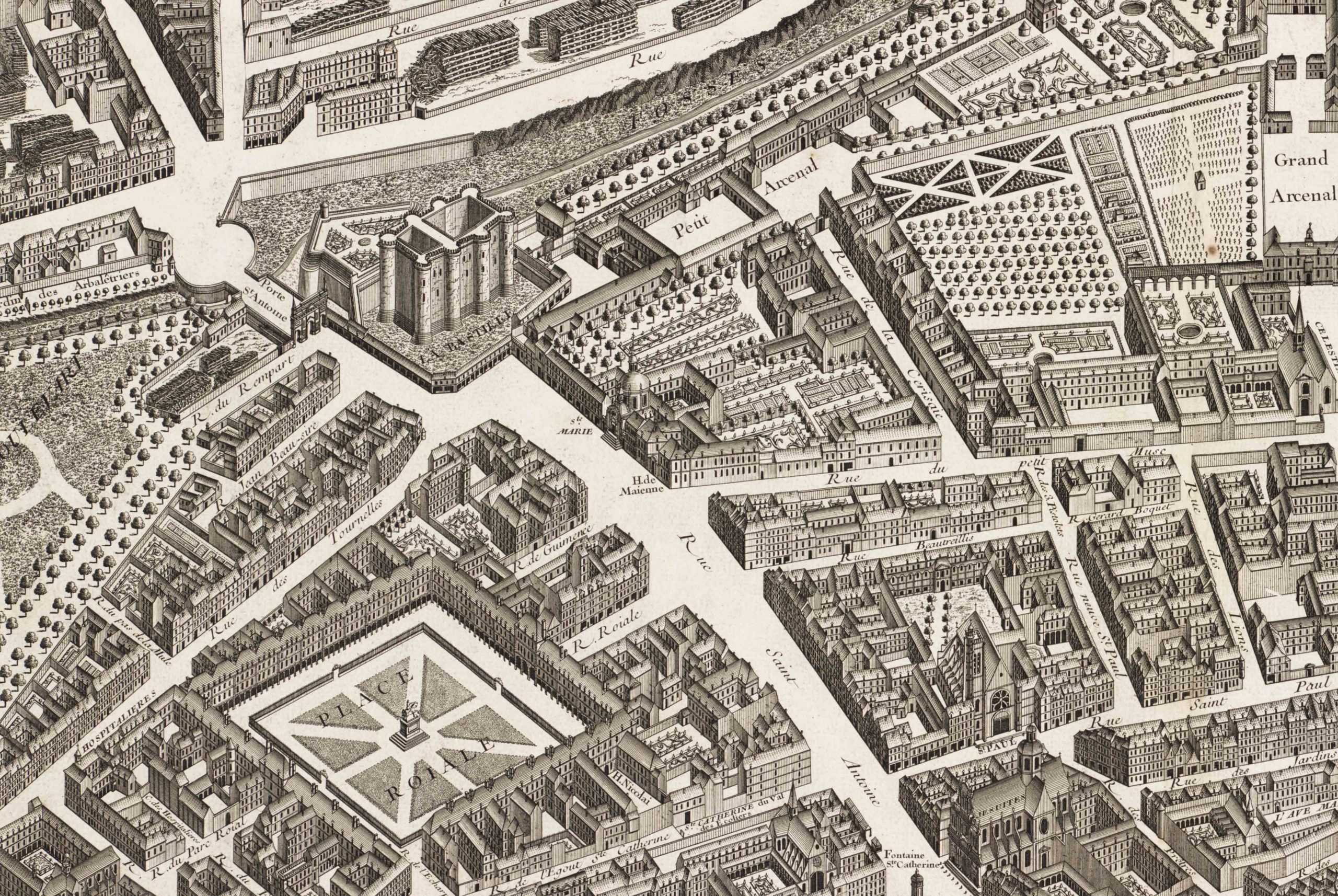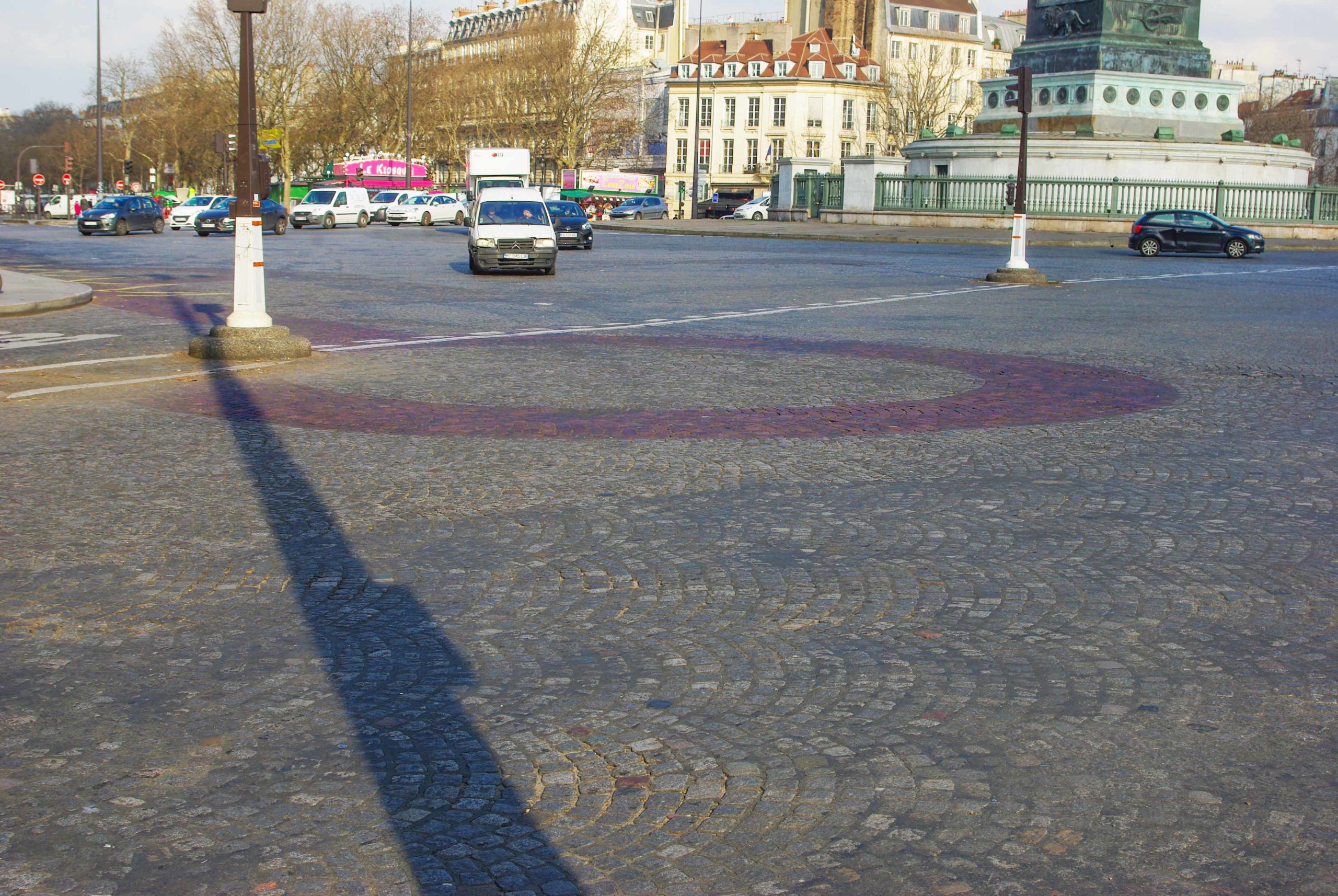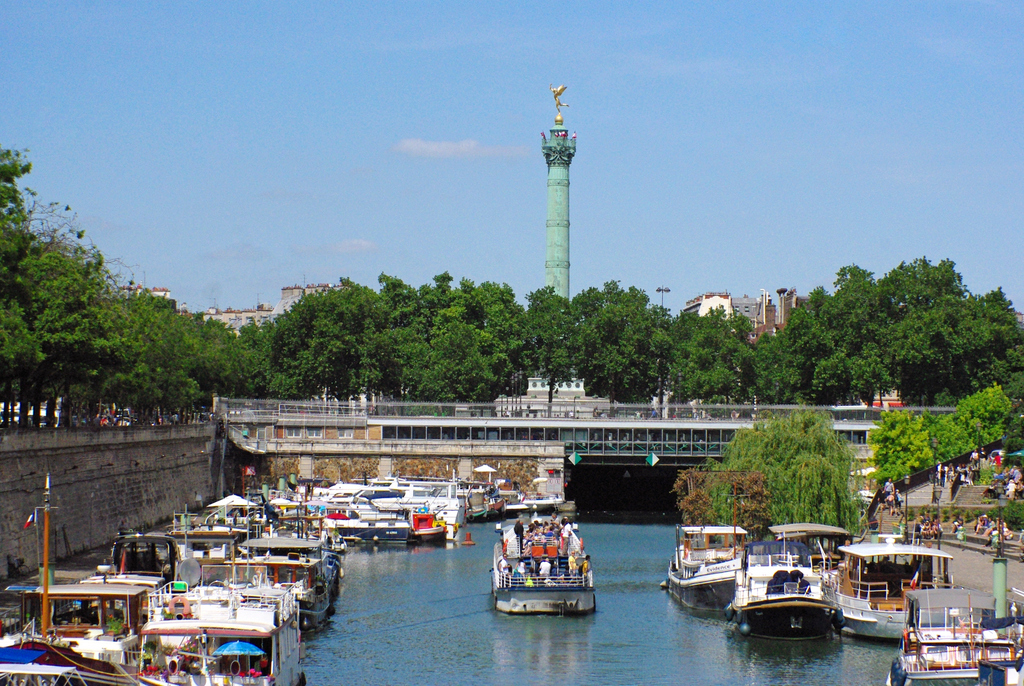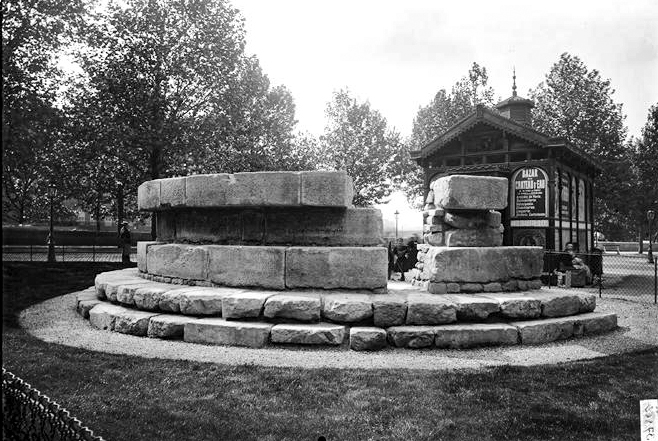The Bastille Fortress is an ancient monument whose name spread worldwide following its storming by the Revolutionaries on 14 July 1789.
This day, engraved in the collective memory of the French, is known as "Bastille Day" in English, while in French, it refers to the "Fête Nationale" or simply "14 July".
The former military citadel, which later became a state prison, may have disappeared from the Parisian landscape, but you can find a few traces still scattered across the French capital. After describing the infamous fortress, we will discover these hidden treasures in Paris (and also in France and the USA!).
About the Bastille Fortress in Paris
Let's start by describing the Bastille fortress in Paris to understand which monument we're talking about.
A small castle
The Bastille was originally a fortification known as a "bastide", consisting of a châtelet with two towers, located at the Saint-Antoine Gate in Charles V's rampart (today Place de la Bastille).

Historical reconstruction of the Bastille in 1420 by Théodore Hoffbauer (1839-1922). Musée Carnavalet
Hastily erected between 1356 and 1358 during the provostship of Étienne Marcel, the Bastille Sainte-Antoine was later transformed into a full-fledged urban castle by King Charles V in 1367.
This new construction comprised eight towers, the first two of which were raised to form an independent bastille with its own garrison.
Its main role was to defend the Porte Saint-Antoine and the ramparts to the east of Paris, which had become more vulnerable. The Bastille also served as protection for the King in the event of an uprising by the Parisian people.
For example, it secured the route between the royal residence at the Hôtel Saint-Pol and Vincennes Castle, where King Charles V wanted to establish the administrative centre of the kingdom.

Bastille Fortress and Saint-Antoine Gate (right) in 1715
Dimensions and towers
The fortress was 66 metres long, 34 metres wide and 24 metres high at the towers. It was surrounded by a moat 25 metres wide and 8 metres deep, fed by the waters of the Seine.

The Eight Towers of the Bastille Fortress in 1750
The eight towers were called :
- Corner Tower [Tour du Coin] (located on the corner of rue Saint-Antoine) ;
- Chapel Tower [Tour de la Chapelle] (in the 15th century, the chapel was located here, later moved to the other side of the courtyard between the Tours de la Liberté and de la Bertaudière);
- Treasure Tower [Tour du Trésor] (in 1580, Henri IV transferred the royal treasury here, which Marie de Médicis had spent during her regency);
- County Tower [Tour de la Comté] (possibly named after the Viscounty of Paris);
- Tour de la Bertaudière or sometimes Bretaudière (the mason Berthaud fell to his death during its construction, this is the tower of the Iron Mask);
- Tour de la Bazinière (Macé Bertrand de la Bazinière, treasurer of the Savings Bank and arrested at the same time as Fouquet in 1661, was locked up there for four years) ;
- Liberty Tower [Tour de la Liberté] (following an assault by Parisians around 1380 to the cry of "Liberté! Liberté!", it was in this tower that Hugues Aubriot was imprisoned under Charles VI), and ;
- Well Tower [Tour du Puits].

Floor map of the Bastille Fortress
An infamous prison
The Bastille was occasionally used as a prison during the reign of Louis XI.
During the turmoil of the Wars of Religion, it was used as a prison by some of the most influential figures in the kingdom, including François de Montmorency (1574-1575), Charles d'Angoulême (1604-1616) and the Prince de Condé (1616-1619).
Under the rule of the League, the Bastille housed the writer Montaigne (1588).
Although the Bastille was mainly used for state prisoners, King Henry IV kept the royal treasury there.
Cardinal de Richelieu transformed it into a state prison to which the lettres de cachet, letters signed by the King (or more often by his ministers) ordering imprisonment without trial, are still attached.
Famous prisoners
On 18 June 1663, Nicolas Fouquet, Superintendent General of Finances, accused of embezzlement, was transferred from Vincennes to the Bastille by order of the King, countersigned by Le Tellier.
The most famous prisoner of the Bastille was the Man in the iron mask, who was interned there on 18 September 1698 at three o'clock in the afternoon. He wore a black velvet mask tied tightly around his face and was housed in the Berthaudière Tower. He died on 19 November 1703.
Voltaire, aged 22, was imprisoned in the Bastille on 17 May 1717 for writing poems against the regent and the Duchess of Berry, who was in an advanced state of pregnancy at the time and had retired to the Château de la Muette to give birth.
The sulphurous Marquis de Sade was held there for five and a half years.
![Man with the iron mask © Prosopee - licence [CC BY-SA 3.0] from Wikimedia Commons Man with the iron mask © Prosopee - licence [CC BY-SA 3.0] from Wikimedia Commons](https://frenchmoments.eu/wp-content/uploads/2023/06/Man-with-the-iron-mask-©-Prosopee-licence-CC-BY-SA-3.0-from-Wikimedia-Commons.jpg)
Man with the iron mask © Prosopee - licence [CC BY-SA 3.0] from Wikimedia Commons

Nicolas Fouquet

Marquis de Sade

Voltaire
A comfortable prison?
The Bastille was a relatively comfortable prison for people of quality (nobles, wealthy citizens) imprisoned in the 42 cells of the fortress.
Royal prisoners were allowed to correspond with the outside world, receive visitors and enjoy relative freedom of movement within the fortress.
In 1789, there were only seven prisoners in the Bastille and their conditions of incarceration were fairly flexible.
A monument in the Paris cityscape
In reality, the Bastille was a financial drain for Louis XVI, not only because of the governor's salary but also because of the upkeep of the staff and the food. Minister Necker wanted to have it demolished as early as 1784. In the mid-1780s, the King's town planners envisaged its demolition to create a pleasant square near the Saint-Antoine district.
The people no longer feared this building on the eve of the French Revolution. Like any imposing fortress, it marked the Parisian landscape and was a symbol of royal despotism.
The "Cahiers de doléances" of the city of Paris, drawn up by members of the parliamentary rebellion, called for it to be demolished and replaced by a square with a monument to Liberty.

The Bastille Fortress and Place des Vosges in the Turgot Map of Paris (1734-1736)
The storming of the Bastille
Today, the storming of the Bastille is regarded as the symbol of the French Revolution, and marks its beginning.
Just after the storming of the Invalides for arms and cannon, the people of Paris stormed the Bastille Fortress on the 14th of July, 1789. The vast majority were rioters from the Faubourg Saint-Antoine, who had come in search of gunpowder and ammunition.
To them, the fortress also symbolised royal power.

Storming of the Bastille - Anonymous painter
The defense of the Bastille Fortress
On that day, a garrison of 114 soldiers defended the Bastille.
Delegations tried to negotiate with the governor of the Bastille, Bernard-René Jourdan de Launay, but to no avail.
After the Revolutionaries stormed the fortress, they took the governor to the Place de Grève, where he was lynched, stabbed, shot and had his head cut off by a butcher.

The arrestation of the Bastille governor - Painting by Jean-Pierre Houël
The treasure of the Bastille recovered
The Revolutionaries seized the Bastille archives and the furniture and crockery and scattered some of it in the ditches of the fortress.
From the 15th of July, the municipal authorities attempted to recover them.
Most of them were transferred to the nearby Bibliothèque de l'Arsenal in 1798. Since the nineteenth century, 60,000 files have been catalogued, mainly comprising lettres de cachet, interrogations, petitions to the king, police reports and correspondence from those imprisoned.

Inside the Pavillon de l'Arsenal © French Moments
The remains of the Bastille Fortress
The memory of the fortress has remained in the mind of Parisians and French people alike.
The Bastille has remained a name associated with a significant event in French history and the place name of a famous Parisian site: the Place de la Bastille.
In the capital and elsewhere in France, the remains of the Bastille can be found like hidden treasures. Here are a few interesting leads:
The Bastille miniatures
A private contractor, Palloy, began demolishing the fortress the next day, on 15 July 1789. However, the Bastille did not disappear from the Parisian landscape immediately. In fact, the demolition work lasted until 1806.

The demolished Bastille Fortress in July 1789
Palloy had the brilliant idea of selling carved stones representing the Bastille in miniature. Following the creation of the départements at the end of 1789, Palloy decided to make models of the Bastille out of the stones of the fortress, for the 83 new administrative centres (chefs-lieux or préfectures).
The scale models were around 40cm high, 100cm long and 60cm deep.
Models were also given to ministers, Louis XVI and foreign personalities such as George Washington (his copy is on display at his estate, Mount Vernon).
You can admire one of them in the Carnavalet Museum, Paris.

Bastille Miniature at Carnavalet Museum © French Moments
The miniatures in the Province
Other places outside of Paris include:
- Auch (Archives départementales du Gers)
- Chartres (Musée des beaux-arts)
- Coutances (Musée Quesnel-Morinière)
- Nancy (Musée lorrain)
- Nantes (Musée Dobrée)
- Pau (Archives départementales des Pyrénées Atlantiques)
- Quimper (Musée départemental breton)
- Le Puy-en-Velay (Musée Crozatier)
- Rouen (Musée départemental des Antiquités)
- Tours (Hôtel Goüin)
- Tulle (Garden of the Musée du Cloître)
- Valence (Musée des beaux-arts)
- Vannes (Archives départementales du Morbihan)
- Versailles (Salle du Jeu de paume)
- Vizille (Musée de la Révolution française)
Place de la Bastille
Of course, you would have to go to the Place de la Bastille to unearth the secrets of the ghost fortress!
The traces of the Bastille
Stand at the corner of Rue Saint-Antoine and Place de la Bastille. On the ground, you'll see a line of cobblestones larger than the others. They mark the outline of the Bastille.

Marks of the fortress on Place de la Bastille © French Moments
Number 3: A tourist hoax?
At number 3 on the Place de la Bastille, you will see a plaque on the façade indicating the position of the old fortress with the current square and thoroughfares. You are standing on the site of the Treasure Tower, which served as the royal vault.

Commemorative Plaque Place de la Bastille © French Moments
On the same building, look up at the semi-circular section that forms the corner. You'll see an incredible detail: a cannonball mark with the inscription "souvenir du 14 juillet 1789".

© French Moments
Nearby, you'll see the date on which the Haussmannian building was completed: 26 May 1871, 80 years after the cannonball arrived!

© French Moments
Is this a tourist hoax? Or was the stone hit perhaps reused in the construction of the building? Nobody knows!
Métro Station Bastille
You can find a piece of the Bastille moat counterscarp wall on a platform in the station of the same name on métro line 5 (the station towards Bobigny - Pablo Picasso).
The other side of this wall can be seen behind glass in the metro corridors, in a staircase leading from the entrance on Boulevard Bourdon.
![Bastille Metro Station Line 5 © 石川 Shihchuan - licence [CC BY-SA 2.0] from Wikimedia Commons Bastille Metro Station Line 5 © 石川 Shihchuan - licence [CC BY-SA 2.0] from Wikimedia Commons](https://frenchmoments.eu/wp-content/uploads/2023/06/Bastille-Metro-Station-Line-5-©-石川-Shihchuan-licence-CC-BY-SA-2.0-from-Wikimedia-Commons.jpg)
The remains of the Bastille's foundations in the Métro Station Line 5 © 石川 Shihchuan - licence [CC BY-SA 2.0] from Wikimedia Commons
Rue Saint-Antoine
The entrance to the fortress was off today's Place de la Bastille, at number 5, Rue Saint-Antoine.
This was the entrance to the forecourt of the Bastille. It was here that the attackers broke through on 14 July 1789.
A commemorative plaque on the wall commemorates that historic day.
Bassin de l'Arsenal
The Bassin de l'Arsenal is nothing more than the old widened ditch that carried water from the Seine into the Bastille moat.
An entire section of the wall can still be seen on the right-hand side facing the Seine. This former ditch wall is now used as a retaining wall for the boulevard Bourbon.

Port de l'Arsenal and July Colomn. The retaining wall is to the left © French Moments
![Ditch of the Bastille. Photo by Tangopaso [Public Domain from Wikimedia Commons] Ditch of the Bastille. Photo by Tangopaso [Public Domain from Wikimedia Commons]](https://frenchmoments.eu/wp-content/uploads/2023/06/Ditch-of-the-Bastille.-Photo-by-Tangopaso-Public-Domain-from-Wikimedia-Commons-scaled.jpg)
Part of the Bastille's wall. Photo by Tangopaso [Public Domain from Wikimedia Commons]
Square Henri-Galli
Hidden away in the greenery of Square Henri-Galli (4th arrondissement, métro station Sully Morland), you could almost pass them by without taking any notice. Yet they are the most important remains of the Bastille.
![Square Henri-Galli © LPLT - licence [CC BY-SA 3.0] from Wikimedia Commons Square Henri-Galli © LPLT - licence [CC BY-SA 3.0] from Wikimedia Commons](https://frenchmoments.eu/wp-content/uploads/2023/06/Square-Henri-Galli-©-LPLT-licence-CC-BY-SA-3.0-from-Wikimedia-Commons-scaled.jpg)
The remains of the Liberty Tower in Square Henri-Galli © LPLT - licence [CC BY-SA 3.0] from Wikimedia Commons
In 1899, when line 1 of the Paris metro was being built, remains of the fortress were discovered at no. 1 rue Saint-Antoine.

The discovering of the Bastille Foundations when building Metro Line 1
The foundations of the Tour de la Liberté (where the Marquis de Sade was imprisoned) were dismantled and reconstructed in the Square Henri-Galli.

The remains of the Liberty Tower in Square Henri-Galli circa 1900
Pont de la Concorde
The Pont de la Concorde is a bridge in Paris that crosses the Seine between the Place de la Concorde (right bank) and the Quai d'Orsay (left bank).

Pont de la Concorde, Paris © French Moments
Before the Revolution, it was known as the "Pont Louis-XVI" when work began in 1787 before being renamed the "Pont de la Révolution" in 1792 and then the "Pont de la Concorde" in 1830.
Architect Jean-Rodolphe Perronet had to work on construction amid the revolutionary turmoil. To do so, he used cut stones from the demolition of the Bastille Fortress, stormed on 14 July 1789, to build the upper part of the bridge "so that the people could continually trample the ancient fortress underfoot".
Construction was completed in 1791.

Pont de la Concorde © French Moments
Pontoise, Val d'Oise
If you happen to visit Pontoise, north-west of Paris, look for the Bastille stone containing an extract from the Declaration of the Rights of Man and of the Citizen at the town hall.
![Bastille Stone in Pontoise Town-Hall © Parisette - licence [CC BY-SA 3.0] from Wikimedia Commons Bastille Stone in Pontoise Town-Hall © Parisette - licence [CC BY-SA 3.0] from Wikimedia Commons](https://frenchmoments.eu/wp-content/uploads/2023/06/Bastille-Stone-in-Pontoise-Town-Hall-©-Parisette-licence-CC-BY-SA-3.0-from-Wikimedia-Commons.jpg)
Bastille Stone in Pontoise Town-Hall © Parisette - licence [CC BY-SA 3.0] from Wikimedia Commons
Chambéry, Savoy
The Musée Savoisien in Chambéry (Savoy) has a stone of the Bastille fortress on display. Palloy offered (sold?) it to the commune of Chambéry in 1793.
![Bastille Stone in Chambéry - Musée Savoisien (Public Domain from Wikimedia Commons] Bastille Stone in Chambéry - Musée Savoisien (Public Domain from Wikimedia Commons]](https://frenchmoments.eu/wp-content/uploads/2023/06/Bastille-Stone-in-Chambery-Musee-Savoisien-Public-Domain-from-Wikimedia-Commons-scaled.jpg)
Bastille Stone in Chambéry - Musée Savoisien (Public Domain from Wikimedia Commons]
Munich, Germany
The Bavarian National Museum in Munich, Germany also has a Palloy stone of the Bastille fortress on display which dates back to 1791.
![Bastille Stone in Kalkstein Bayerisches Nationalmuseum München [Public Domain from Wikimedia Commons] Bastille Stone in Kalkstein Bayerisches Nationalmuseum München [Public Domain from Wikimedia Commons]](https://frenchmoments.eu/wp-content/uploads/2023/06/Bastille-Stone-in-Kalkstein-Bayerisches-Nationalmuseum-Munchen-Public-Domain-from-Wikimedia-Commons.jpg)
Bastille Stone on diaplay at the Bayerisches Nationalmuseum München [Public Domain from Wikimedia Commons]
L'Isle-Jourdain, Occitania
The Musée Européen d'Art Campanaire (European Museum of Bell Art) in L'Isle-Jourdain (Gers) currently houses the former carillon of the Bastille Fortress.
![Bastille Carillon L'Isle Jourdain © Campanophile - licence [CC BY-SA 3.0] from Wikimedia Commons Bastille Carillon L'Isle Jourdain © Campanophile - licence [CC BY-SA 3.0] from Wikimedia Commons](https://frenchmoments.eu/wp-content/uploads/2023/06/Bastille-Carillon-LIsle-Jourdain-©-Campanophile-licence-CC-BY-SA-3.0-from-Wikimedia-Commons.jpg)
The Bastille Carillon at the Bell Museum in L'Isle Jourdain © Campanophile - licence [CC BY-SA 3.0] from Wikimedia Commons
Mount Vernon residence, USA
Angry citizens of Paris turned over the main prison key of the Bastille Fortress to the thirty-two-year-old Marquis de Lafayette shortly after the storming of the Bastille.
Lafayette then crossed the Atlantic to America in March 1790 with the Bastille Key as a gift to George Washington. The President of the United States received the key in the late summer of 1790, which was first publicly shown in New York and then showcased in Philadelphia. George Washington transferred the Bastille key to Mount Vernon residence in 1797, where it is on display today.
The legacy of the Bastille Fortress
As we conclude our journey tracing the remains of the Bastille Fortress, we are reminded of the enduring legacy and significance of this iconic stronghold.
By exploring its walls' vestiges and immersing ourselves in its historical context, we have connected with the spirit of revolution that once coursed through its chambers. The Bastille Fortress is a testament to the power of collective action and the pursuit of liberty.
As you stroll through the streets of Paris, may the echoes of the Bastille inspire you to delve deeper into the captivating history beneath the surface of this enchanting city.

Place de la Bastille © French Moments
If you enjoy the reading, please share this article on Facebook, Twitter or Pinterest!




